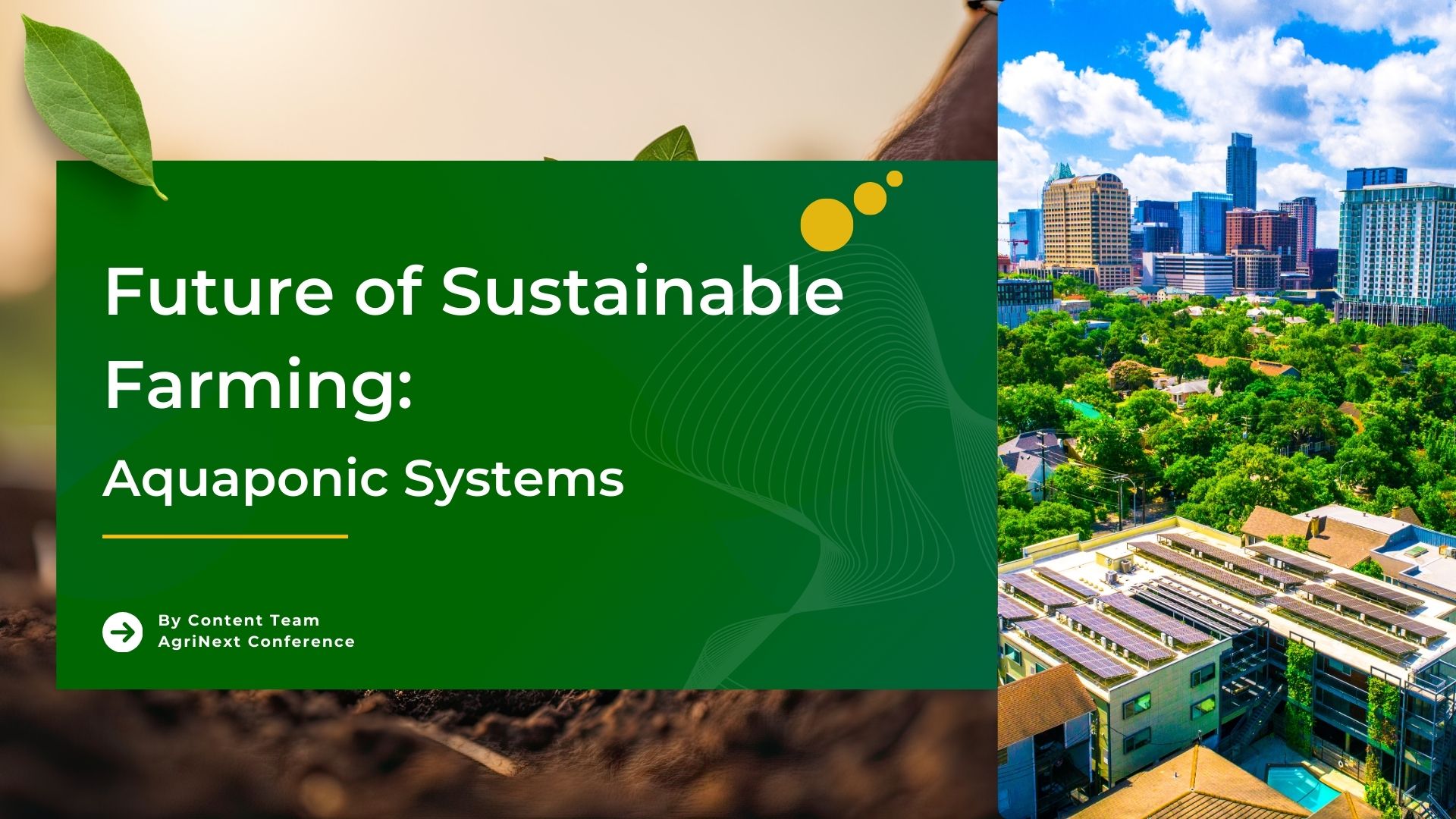
In the quest for sustainable and efficient food production, innovative cultivation methods such as hydroponics, aeroponics, and aquaponics are gaining significant attention in agriculture. These soilless techniques offer numerous advantages, including increased crop yields, efficient nutrient management, and reduced environmental impact.This blog explores the mechanisms, innovative technologies, and other aspects of aquaponics systems. This innovative system merges aquaculture (raising fish) with hydroponics (growing plants without soil), creating a symbiotic environment where both fish and plants thrive.
Table of Contents

Understanding Aquaponics
Aquaponics is a closed-loop system where fish waste provides an organic nutrient source for plants, and the plants help purify the water for the fish.Here are the different components of the aquaponics system.
Fish Tank:
Fish are raised in a tank where they produce waste.
Biofilter:
Bacteria convert ammonia from fish waste into nitrates, which are essential nutrients for plants.
Plant Beds:
Plants are grown in water-based systems where their roots absorb the nitrates, cleaning the water.Grow media Or floating rafts give support to the plants.
Water Recirculation:
The purified water is cycled back to the fish tank, maintaining a healthy environment for the fish.A water pump helps water circulate through the entire system and aids in aeration.
Innovative Technologies Enhancing Aquaponics
Aquaponics, the harmonious integration of aquaculture (raising fish) and hydroponics (growing plants without soil), is gaining traction as a sustainable farming method. Recent technological advancements have further improved the efficiency and sustainability of aquaponic systems. Here are some key technologies being applied in aquaponics:
Effective Microbes (EM) in Controlling Water Quality
Effective Microbes (EM) are beneficial microorganisms that play a crucial role in maintaining optimal water quality in aquaponic systems. By breaking down organic waste and reducing harmful pathogens, EM helps create a balanced microbial environment, which is essential for the health of both fish and plants.
Biofloc Technology
Biofloc technology involves cultivating beneficial microbial communities within the aquaponic system. These microbes convert waste into protein-rich biomass, which can be utilized by fish, thereby reducing the need for external feed. This not only enhances water quality but also supports the growth and health of the aquatic organisms.
Aquamimicry
Aquamimicry seeks to replicate natural aquatic ecosystems by using natural feed and habitat structures. This approach can enhance fish growth and health by providing a more natural living environment, reducing reliance on artificial feeds, and improving the resilience of the system against diseases.
Black Soldier Fly (BSF) as Supplemental Protein Feed
Using Black Soldier Fly larvae as a supplemental protein feed is an innovative and sustainable practice in aquaponics. BSF larvae are an excellent source of high-quality protein for fish and help reduce the dependence on traditional fishmeal, promoting waste recycling and sustainability.
Probiotic and Prebiotic Applications
The application of probiotics and prebiotics in aquaponics can significantly boost the health and growth of both fish and plants. Probiotics introduce beneficial bacteria into the system, while prebiotics promote their growth. Together, they enhance gut health, strengthen immune responses, and improve overall system productivity.
Internet of Things (IoT)in Monitoring Water Quality
IoT technology is revolutionizing water quality management in aquaponics. By using sensors and connected devices, IoT systems provide real-time monitoring of key water parameters, enabling immediate responses to any changes. This continuous monitoring ensures optimal conditions for both fish and plants, enhancing system efficiency and reducing labour costs.
The integration of these innovative technologies in aquaponics not only improves the efficiency and sustainability of the systems but also promotes healthier growth for both fish and plants. By utilizing these advancements, aquaponics can become an even more viable and environmentally friendly method of food production, contributing significantly to sustainable agriculture practices.
Benefits of aquaponics
Sustainable Nutrient Cycling
Aquaponics mimics the natural nutrient cycles found in ecosystems, where waste from one organism becomes food for another. By harnessing this natural process, aquaponics eliminates the need for synthetic fertilizers, as the fish waste provides a continuous supply of nutrients for the plants. This closed-loop system conserves water and minimizes nutrient runoff, making it a highly sustainable farming method.
Efficient Use of Resources
Aquaponics is an efficient farming method that maximizes the use of available resources. The integration of fish and plants in a single system allows for the efficient use of space, as both aquatic and plant crops can be cultivated in the same area. Additionally, aquaponics uses significantly less water than traditional soil-based agriculture, as water is recirculated within the system rather than being lost to evaporation or runoff
The Different Types of aquaponic systems
Media Based Aquaponics System
The media-based system, also known as Flood and Drain, is common for small-scale aquaponics. It’s popular among DIY(do it yourself) home growers because it’s easy to operate. This system is simple and efficient with space, has a low initial cost, and is suitable for beginners in aquaponics.
Nutrient Film Technique (NFT) Aquaponic Systems
The Nutrient Film Technique (NFT) is a hydroponic method adapted for aquaponics due to its simple and effective design. It uses horizontal pipes (typically PVC) with shallow streams of nutrient-rich water flowing through them, taking advantage of gravity. NFT is popular in commercial aquaponics and is especially useful in urban areas where space and food production are limited.
Raft Aquaponics System
Also known as the Deep Water Culture (DWC), the raft system of aquaponics is one of the most efficient aquaponics system designs. In raft systems, plants are suspended with their roots directly immersed in a nutrient-rich, oxygenated water solution. This method provides an oxygen-rich environment for the roots, promoting rapid nutrient uptake and robust plant growth. This system is often used in large-scale or commercial aquaponic systems because of its mass production capability.
Vertical Aquaponics System
Vertical aquaponic systems take advantage of vertical space to maximize plant cultivation and utilize aquaponic principles. In these systems, plants are arranged in vertical tiers, often using towers, columns, or wall-mounted structures. The vertical orientation allows for efficient space utilization, making it particularly suitable for environments with limited horizontal space.
Hybrid Aquaponics System
Hybrid aquaponic systems combine different aquaponic methods to create a more efficient and flexible setup. These systems mix elements from various techniques like media-based beds, NFT (Nutrient Film Technique), and raft systems. For example, a hybrid system might use media beds for better filtration and stability, along with NFT channels for efficient nutrient delivery to certain plants. This approach allows growers to customize their system to meet specific needs and optimize performance.
Challenges and Considerations for Aquaponics Systems
Common Issues in Aquaponics
- Water Quality Fluctuations
- Fish Health Concerns
- Nutrient Imbalances
- Temperature Variations
Water Quality Fluctuations: Maintaining stable water parameters, including pH levels, ammonia, nitrite, and nitrate levels, can be challenging. Fluctuations may stress fish and hinder plant growth.
Fish Health Concerns: Fish diseases or stress can quickly spread in confined aquaponic systems. Monitoring fish health is crucial to preventing outbreaks impacting the entire ecosystem.
Nutrient Imbalances: Achieving a balanced nutrient ratio for plants is vital. Overfeeding fish or insufficient bio filtration can lead to nutrient imbalances, affecting plant growth.
Temperature Variations: Aquaponic systems are sensitive to temperature changes. Extreme temperatures can impact the metabolic rates of both fish and beneficial bacteria.
Tips for a Successful Aquaponics Startup
Use Local Fish Species:
Select fish that are readily available locally and can thrive in the chosen climate. This reduces the cost of importing fish and saves money on transportation.
Grow Plants that are in High Demand:
Focus on growing crops with high demand, such as lettuce, tomatoes, and herbs, to increase sales revenue.
Use Energy-Efficient Equipment:
Utilize LED lights for plant growth and install solar panels to reduce energy costs and enhance sustainability.
Revolutionizing Home Gardening with Simple Aquaponics Solutions
AquaSprouts
AquaSprouts exists to make the innovation and excitement of aquaponics and hydroponics accessible to everyone
Founded:
AquaSprouts was founded with a mission to bring aquaponics to homes, schools, and communities.
Approach:
AquaSprouts focuses on providing user-friendly, educational aquaponic systems that make it easy for individuals and institutions to start their own aquaponic gardens.
Innovations:
They developed the AquaSprouts Garden, a versatile aquaponics kit that fits standard 10-gallon aquariums. This kit simplifies the process of setting up and maintaining an aquaponics system, making it accessible to beginners and educational programs.
Products:
The AquaSprouts Garden kit is designed to grow a variety of plants such as herbs, leafy greens, and small vegetables, while simultaneously supporting a small fish habitat.
Impact:
AquaSprouts aims to promote sustainability and environmental education by making aquaponics technology accessible to a wide audience.
Their products are used in homes, schools, and community centers, fostering an understanding of sustainable farming practices and the benefits of aquaponics.AquaSprouts is a great example of how aquaponics can be made accessible and educational, helping to promote sustainable agriculture practices on a smaller scale.
Conclusion
Aquaponic systems represent a sustainable, efficient, and innovative approach to food production. By merging aquaculture with hydroponics, these systems offer numerous environmental and economic benefits. While there are challenges to overcome, the growing market demand and advancements in technology make aquaponics a compelling option for the future of agriculture. Whether you’re an aspiring farmer, a community organizer, or simply an enthusiast, aquaponics offers a path toward a more sustainable and resilient food system.
Signup For AgriNext Conference Newsletter


